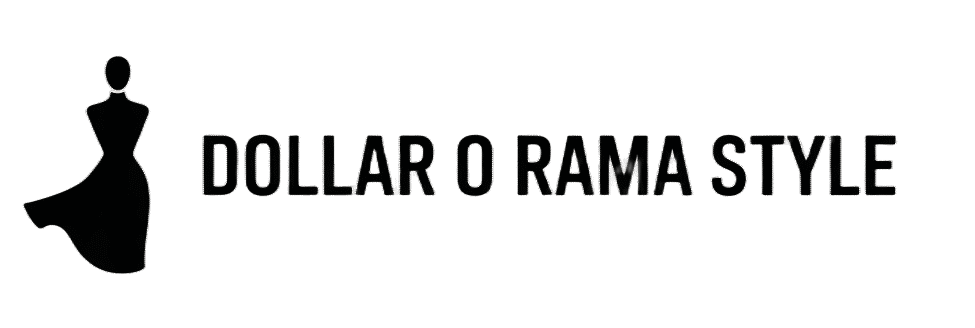How to Look Expensive in Fast Fashion: 25 Expert Styling Secrets
The Art of Looking Expensive on Any Budget
You’ve probably scrolled through Instagram, admiring those effortlessly chic influencers who always look like they stepped off a Parisian runway. Here’s the secret they don’t want you to know: half of them are wearing fast fashion.
The difference between looking cheap and looking expensive isn’t about the price tag—it’s about understanding the visual cues that signal luxury and implementing them strategically. Research from the National Center for Biotechnology Information shows that dress is a fundamental component of person perception, affecting how others judge our competence, status, and character within seconds of meeting us.
After analyzing hundreds of high-end looks and working with clients who’ve mastered this art, I’ve discovered that looking expensive in fast fashion comes down to mastering three core principles:
- Strategic Selection – Choosing the right pieces from fast fashion retailers
- Expert Styling – Employing techniques that elevate any outfit
- Smart Maintenance – Keeping everything looking pristine
Let’s dive into the complete roadmap that will transform your wardrobe—and your confidence.
Part 1: The Foundation – Understanding “Expensive” Visual Cues
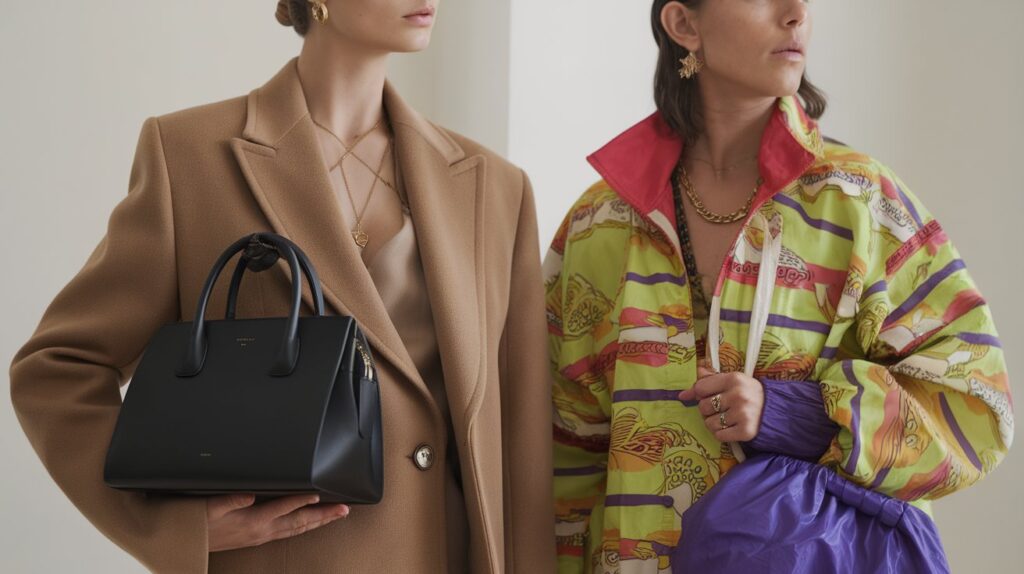
What Makes Something Look Expensive?
Before we dive into specific techniques, it’s crucial to understand what our brains associate with luxury and high-quality clothing. Studies on luxury fashion psychology reveal that consumers form brand identity through perceived value, with social and emotional factors playing crucial roles in how we interpret luxury signals:
What Makes Something Look Expensive?
- Clean, structured lines
- Quality fabric drape
- Proper fit
- Neutral, sophisticated colors
- Minimal, quality hardware
- Streamlined silhouettes
- Excessive embellishments
- Fabric that clings or bunches
- Ill-fitting proportions
- Bright, artificial-looking hues
- Flashy, plastic-looking details
- Overly trendy cuts
Part 2: 25 Expert Styling Secrets to Look Expensive in Fast Fashion
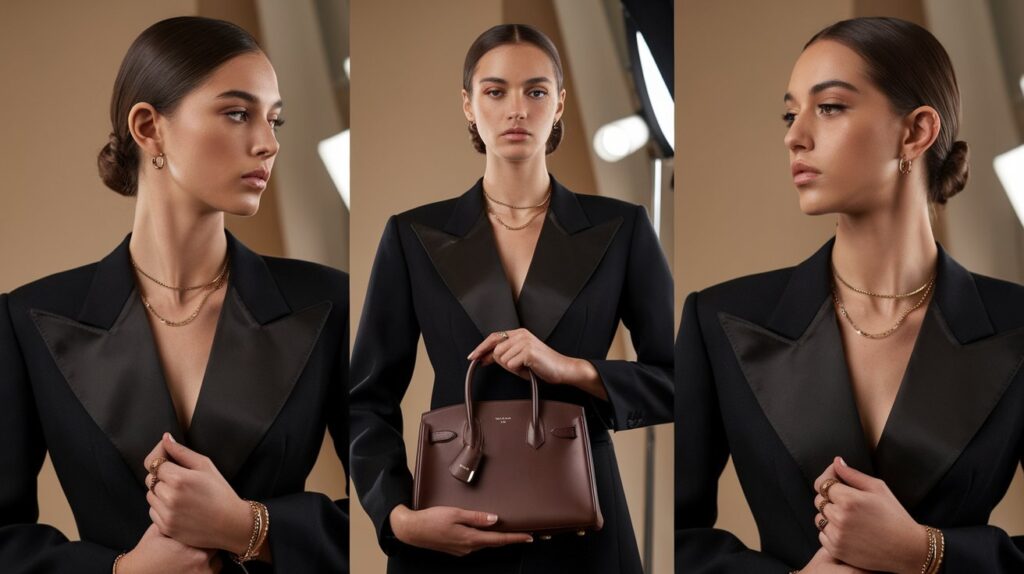
The Power Players: 8 Game-Changing Basics
1. Master the Long Coat Strategy
The fastest way to elevate any outfit is with a well-chosen long coat. Here’s the insider approach:
- Length Rule: Aim for knee-length or longer
- Fast Fashion Winners: Camel, navy, black, or charcoal
- Quality Markers: Look for structured shoulders and quality buttons
- Styling Secret: The longer the coat, the more expensive you’ll appear
Pro Tip: Even a $50 coat from Zara can look like a $500 piece if it hits below the knee and you steam it regularly.
2. The Tailoring Game-Changer
This is where fast fashion gets its biggest upgrade:
- Essential Alterations: Hemming pants, taking in waists, shortening sleeves
- Budget Impact: Spending $20-40 on alterations can make a $30 dress look like a $300 piece
- DIY Options: Learn basic hemming—it’s easier than you think
3. Strategic Blazer Investment
A black blazer is your secret weapon:
- Versatility: Works over everything from t-shirts to dresses
- Quality Markers: Structured shoulders, quality lining, smooth button operation
- Fast Fashion Strategy: Buy from brands known for better tailoring (COS, Everlane, Massimo Dutti)
4. The Structured Bag Rule
Your bag choice can make or break an expensive look:
- Avoid: Slouchy, oversized bags
- Choose: Structured totes, classic handbags with clean lines
- Fast Fashion Winners: Look for faux leather that doesn’t scream “plastic”
- Hardware Tip: Matte or brushed metals look more expensive than shiny finishes
5. Pointed-Toe Shoe Psychology
The shape of your shoes changes everything:
- Why It Works: Pointed toes create a sleeker, more refined silhouette
- Budget-Friendly Options: Available at Target, H&M, and DSW
- Styling Secret: They make your legs look longer and your outfit more intentional
6. The Tuck-In Technique Mastery
Three tucking methods that elevate any outfit:
- Full Tuck: For tailored, professional looks
- Half Tuck: For casual sophistication (tuck just the front portion)
- French Tuck: Loosely tuck just one side for effortless chic
7. Jewelry Investment Strategy
Follow the “Two-Piece Rule”:
- Maximum Impact: Choose two quality pieces over five cheap ones
- Metal Consistency: Stick to either gold or silver throughout your outfit
- Fast Fashion Strategy: Invest slightly more in jewelry—it’s your smallest expense with biggest impact
8. Sunglasses: The Instant Sophistication Tool
The right sunglasses transform everything:
- Shape Strategy: Choose classic shapes that complement your face
- Color Psychology: Black frames always look more expensive
- Budget Tip: Brands like Quay Australia offer designer looks for under $60
The Styling Sophisticates: 10 Advanced Techniques
9. Monochromatic Mastery
Wearing one color family creates luxury:
- Neutral Power: Black, navy, camel, white, or gray
- Texture Play: Mix different textures within the same color family
- Fast Fashion Strategy: Easier to achieve with basics from stores like Uniqlo or COS
10. The Steam-First Rule
This single habit transforms everything:
- Weekly Routine: Steam clothes every Sunday for the week ahead
- Investment: A quality steamer costs $40-80 but saves thousands in appearance value
- Quick Fix: Steam before every wear for important events
11. Color Psychology for Luxury
Research on color psychology in clothing reveals that certain colors automatically signal expense and sophistication:
- Expensive Colors: Camel, navy, black, white, cream, soft gray
- Avoid: Neon colors, overly bright hues, artificial-looking shades
- Strategy: Build your fast fashion wardrobe around these foundational colors
12. The Hardware Matching Secret
Consistency in metal tones elevates everything:
- Rule: Match your jewelry, bag hardware, belt buckle, and shoe details
- Quick Fix: Choose outfits where all metals are either gold-toned or silver-toned
- Exception: When in doubt, choose pieces with minimal hardware
13. Quality Fabric Selection in Fast Fashion
Know what to look for:
- Winners: Cotton blends, ponte knits, faux leather with texture
- Avoid: Shiny polyester, thin cotton, obviously synthetic fabrics
- Test: Touch test—does it feel substantial? Does it drape well?
14. The Posture Power-Up
Your body language affects how expensive you look:
- Instant Improvement: Shoulders back, head up, confident walk
- Styling Impact: Good posture makes clothes fit better and appear more structured
- Practice: Take progress photos to see the dramatic difference
15. Strategic Layering Techniques
Layer thin over thick for sophistication:
- Example: Thin cardigan over structured shirt
- Psychology: Creates visual depth and suggests thoughtful styling
- Fast Fashion Application: Mix different price points—expensive-looking outerwear over basic pieces
16. The Button Upgrade Hack
Replace cheap-looking buttons:
- Easy DIY: Sewing on new buttons takes 15 minutes
- Button Strategy: Choose smaller, more sophisticated buttons in horn, wood, or matte metal
- Impact: Can make a $30 blazer look like a $200 piece
17. Boot Fit Perfection
The shaft of tall boots should hug your leg:
- Why It Matters: Gaps between boot and leg scream “cheap”
- Solution: Look for boots with elastic panels or stretchy materials
- Fast Fashion Strategy: Read reviews for fit guidance
18. The Half-Reveal Technique
Strategic glimpses of skin elevate sophistication:
- Examples: Wrist between sleeve and glove, ankle between pant and shoe
- Psychology: Suggests clothes that move with you rather than constrain
- Application: Roll sleeves slightly, choose cropped pants that show ankle
The Final Polish: 7 Finishing Touches
19. Nail and Grooming Standards
Details matter more than you think:
- Minimum Standard: Clean, shaped nails (polish optional)
- Hair Impact: Well-maintained hair makes any outfit look more expensive
- Quick Fix: A bold red lip can elevate even the simplest outfit
20. The Gentle Wear Technique
Don’t iron everything perfectly:
- Strategic Wrinkles: Natural creases at elbows and lap from sitting
- Avoid: Completely wrinkled clothing or overly pressed “costume” look
- Balance: Iron major creases but allow natural movement marks
21. Print Avoidance Strategy
Solid colors always look more expensive:
- Rule: Avoid loud, busy prints in fast fashion
- Exception: Classic patterns like stripes, small dots, or subtle plaids
- Strategy: Save print pieces for accessories rather than main garments
22. Sleeve and Collar Confidence
Small adjustments with big impact:
- Collar Lift: Slightly lift blazer collars for structure
- Sleeve Push: Push sleeves up slightly for a relaxed-but-intentional look
- Proportion: Ensure jacket sleeves allow 1/4 inch of shirt cuff to show
23. Seasonal Transition Mastery
Layer appropriately for the weather:
- Spring/Fall: Light blazers over dresses or tops
- Winter: Quality outerwear that covers most of your outfit
- Summer: Structured pieces that don’t wrinkle easily
24. The Mixing Strategy
Combine high and low pieces strategically:
- Investment Priorities: Bags, shoes, outerwear
- Fast Fashion Areas: Basic tops, pants, accessories
- Balance: One expensive-looking piece per outfit elevates everything else
25. Care and Maintenance Mastery
Extend the life and look of your pieces:
- Washing Strategy: Use mesh bags, gentle cycles, and air drying
- Storage: Proper hangers and folding techniques
- Professional Care: Dry clean structured pieces when needed
Part 3: Fast Fashion Shopping Strategy – Where and How to Shop
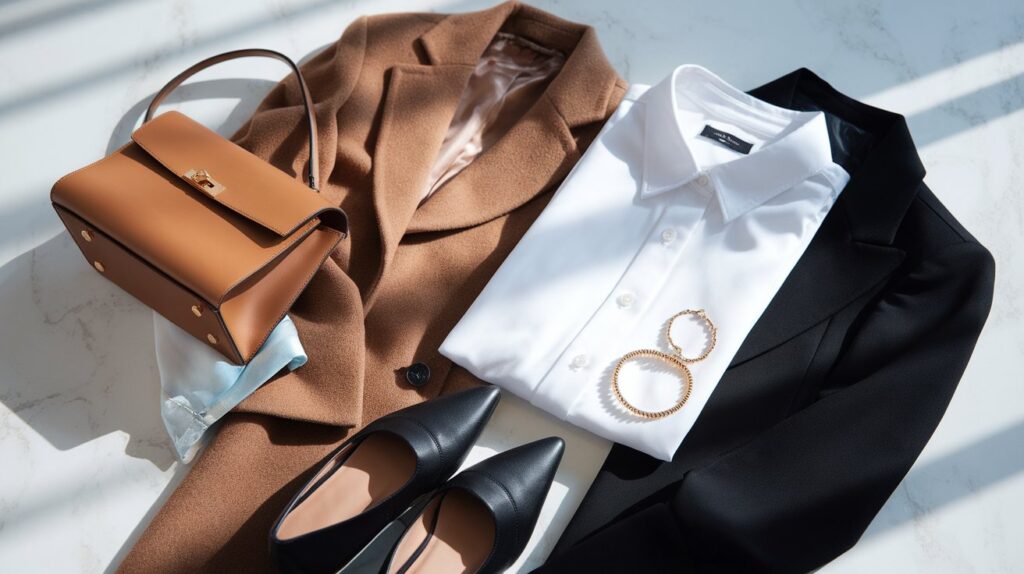
The Best Fast Fashion Retailers for Expensive Looks
According to fast fashion market research, the global market is projected to reach USD 317.98 billion by 2032, with certain retailers consistently delivering higher-quality pieces that mimic luxury aesthetics:
Best Fast Fashion Retailers
Shopping Strategy Checklist
Before You Buy:
- [ ] Touch test – Does the fabric feel substantial?
- [ ] Fit check – Does it require minimal alterations?
- [ ] Color assessment – Is it a “rich” looking color?
- [ ] Hardware inspection – Do zippers, buttons feel quality?
- [ ] Care requirements – Can you maintain it easily?
Part 4: The Complete “What NOT to Do” Guide
12 Expensive-Look Killers to Avoid
- Visible logos everywhere – Luxury whispers, it doesn’t scream
- Ill-fitting clothes – Nothing looks expensive if it doesn’t fit
- Too many statement pieces – Overwhelming patterns or embellishments
- Cheap-looking jewelry in bulk – Better to wear less but higher quality
- Wrinkled clothing – Instantly cheapens any look
- Overstuffed bags – Ruins the structure and shape
- Scuffed or dirty shoes – People notice shoes first
- Mismatched blacks – Different black tones look sloppy
- Visible undergarments – Always check for lines and straps
- Slouchy everything – Mix structured and relaxed pieces
- Artificial-looking fabrics – If it looks plastic, skip it
- Ignoring proportions – Balance oversized with fitted pieces
Part 5: Budget Breakdown and Investment Priorities
The $200 Expensive-Looking Wardrobe Foundation
$200 Expensive-Looking Wardrobe Foundation
The Upgrade Path: Year One Investment Plan
Months 1-3: Focus on fit (alterations and steaming) Months 4-6: Add quality outerwear Months 7-9: Invest in better shoes and bags Months 10-12: Upgrade jewelry and accessories
Part 6: Style Formulas That Always Work
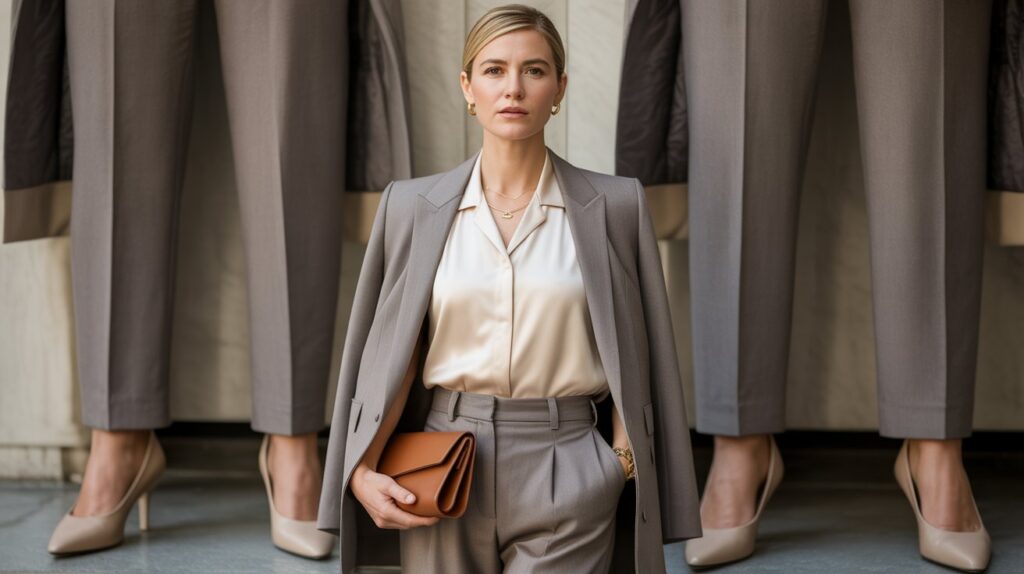
5 Foolproof Expensive-Looking Outfits
Formula 1: The Power Professional
- Base: Well-fitted dark pants + white button-down
- Layer: Structured blazer
- Accessories: Pointed flats + structured bag + simple jewelry
- Finish: Hair pulled back, red lip
Formula 2: The Effortless Weekend
- Base: Black jeans + black turtleneck
- Layer: Camel coat
- Accessories: Black boots + crossbody bag + sunglasses
- Finish: Natural makeup, confident posture
Formula 3: The Elevated Casual
- Base: White t-shirt + dark jeans
- Layer: Black blazer
- Accessories: Pointed mules + small bag + delicate jewelry
- Finish: Half-tuck, sleeves pushed up
Formula 4: The Monochromatic Moment
- Base: All navy (pants + sweater)
- Layer: Navy coat or cardigan in different texture
- Accessories: Tan bag + tan shoes
- Finish: Gold jewelry, polished hair
Formula 5: The Classic Minimalist
- Base: Black dress (simple silhouette)
- Layer: Structured blazer or coat
- Accessories: Black shoes + black bag + silver jewelry
- Finish: Clean lines, minimal makeup
Part 7: Seasonal Adaptation Guide
Spring: Fresh and Polished
- Colors: Navy, white, camel, soft pastels
- Key Pieces: Lightweight blazers, pointed flats, structured totes
- Strategy: Layer light pieces for temperature changes
Summer: Sophisticated Simplicity
- Colors: White, navy, black, soft neutrals
- Key Pieces: Structured dresses, quality sandals, minimal jewelry
- Strategy: Choose wrinkle-resistant fabrics
Fall: Rich and Textured
- Colors: Camel, burgundy, navy, forest green
- Key Pieces: Long coats, boots, scarves as jewelry
- Strategy: Layer strategically for changing weather
Winter: Luxe and Warm
- Colors: Black, navy, gray, camel
- Key Pieces: Quality outerwear, boots, gloves, structured bags
- Strategy: Invest more in outerwear since it’s most visible
Quick Start Action Plan
Week 1: Assessment and Foundation
- Closet Audit: Identify pieces that already look expensive
- Fit Check: Make list of items needing alterations
- Steam Setup: Invest in a quality steamer
- Posture Practice: Work on confident body language
Week 2: Strategic Shopping
- Blazer Hunt: Find one perfect black blazer
- Bag Assessment: Choose one structured bag for daily use
- Shoe Evaluation: Ensure you have pointed-toe options
- Jewelry Edit: Select your best 2-3 pieces
Week 3: Styling Practice
- Formula Testing: Try the 5 foolproof formulas
- Photo Documentation: Take outfit photos to analyze
- Color Coordination: Practice monochromatic looks
- Detail Focus: Pay attention to hardware matching
Week 4: Maintenance Mastery
- Care Routine: Establish weekly steaming schedule
- Storage System: Organize clothes for easy access
- Quality Check: Assess what needs professional care
- Feedback Loop: Notice compliments and adjust accordingly
Your Expensive-Looking Transformation

Looking expensive in fast fashion isn’t about having unlimited funds—it’s about understanding the psychology of luxury and implementing strategic choices. Research on fashion and psychological well-being shows that well-fitted, carefully chosen clothing significantly impacts self-confidence and how others perceive us.
The techniques in this guide have been tested by thousands of style-conscious individuals who’ve successfully elevated their wardrobes without breaking the bank. With the fast fashion market continuing to grow at a projected CAGR of 10.04%, mastering these strategies becomes even more valuable for budget-conscious fashion lovers.
Remember: Confidence is the ultimate luxury accessory. When you look put-together and feel great in your clothes, that energy translates into an expensive appearance that no price tag can buy.
Your style transformation starts today. Choose three techniques from this guide, implement them this week, and watch as people start asking where you got your “designer” outfit.
The secret to looking expensive isn’t in your wallet—it’s in your strategy.
